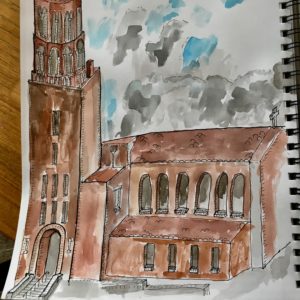Churches for Sale
Two once prominent Seattle churches have voted in recent weeks to sell their buildings.
 One of those is Trinity United Methodist Church. Trinity is located at 65th and 22nd in Ballard. It is quite a large building for a neighborhood church. And there is additional property across the street that serves as a parking lot. For the past year I have rented an office space at Trinity. Here is sketch (cut off at the top) I did of that church earlier this spring. As you can see, it has a beautiful, high tower that looks like something in Italy.
One of those is Trinity United Methodist Church. Trinity is located at 65th and 22nd in Ballard. It is quite a large building for a neighborhood church. And there is additional property across the street that serves as a parking lot. For the past year I have rented an office space at Trinity. Here is sketch (cut off at the top) I did of that church earlier this spring. As you can see, it has a beautiful, high tower that looks like something in Italy.
Trinity hosts a lunch every Saturday for homeless people in Ballard in its old gym. I have worked in the Trinity kitchen on a number of Saturday mornings to prepare that meal, and enjoyed the fellowship of doing so.
Another church that has come to same decision is University Disciples Church at 50th and 15th in the U-District. This too is a very large, even grand, facility. And a half-dozen or so blocks to the south on 15th is its mirror image, University Methodist Temple. Both were designed by the same architect.
For some years there was great energy among half-dozen university district churches to form a unified ecumenical parish. The idea was for all the congregations to share the University Methodist Temple facility. Despite high hopes, that vision never got translated into reality.
In both cases, Trinity and University Disciples, the church building reflects a very different era than ours in the 21st century. In the 1950’s University Disciples would have had a membership in excess of 2,000. I don’t know, but my guess, is that Trinity would have been nearly 1,000 members at that time. Today, both congregations have worshipping communities of 50 to 60. Their buildings are not only way too large for their needs, but they are very expensive to maintain.
I’m not sure what the re-sale market will be for either one. Given the housing situation in Seattle, it wouldn’t surprise me to see both demolished and replaced by multi-story housing.
My colleague Donna Schaper recently published an article in The Christian Century titled “Opening Up God’s House.” She encourages congregations to think creatively about stewarding their buildings. Here’s Donna:
“A church is both building and people, bricks and mortals. First came the attendance decline among mortals; a bricks crisis followed. Now church buildings are an endangered species. Drive through any American town and you might see a former church with weeds coming up out of the sidewalks, the door half hinged, the sign unpainted.”
The bulk of Donna’s article is about how churches can re-conceive how they think about and use their facilities to cope with a decline in mortals and yet maintain the bricks — and do it all with a sense of joy and purpose.
But still, she writes, you have to face the big question: “Why bother to save church buildings? This is the most important question.”
Donna reports on her Manhattan congregation, Judson Memorial, referencing the two-point policy that guides them. “This two-point policy — maximize income for maintenance and maximize mission for ministry — is expensive. Half our full-time staff is focused on managing the building and our tenants. Each week, 2,200 people come through our doors. Our congregation of 380 or so worships alongside three other congregations. The building’s gym is now a theater, available for rent. A dance company and school use the building on Monday nights; Tuesday nights the West Village Chorale rehearses. We also rent to movie companies and other market-rate groups as space is available. It rarely is.”
This is church that has taken seriously the management and stewardship of their asset!
When church’s close or move and sell historic buildings, it is usually painful, but it can also be the right, even faithful, decision. Despite the way that we build things to suggest permanence, our buildings are not eternal.
Still, when a church closes or sells, more is lost than only a building. Usually, as at Trinity, lots of community things have gone on in the building for many years. (On the floor where I have my office, there are at least half a dozen NGO’s quartered including “Earth Ministry,” “Yoga Behind Bars,” and “Boys/Girls Club.”)
Moreover, these church buildings are a kind of public art (inadequately suggested by my sketch), one that provides a meaningful symbol to a neighborhood, even for people who are not a part of it.
Donna cautions helpfully, “Don’t set up a binary between the building and the people. Remember the finger game about the church with the steeple and the people? The game is right. The spiritual and the material, the communal and the physical — it’s all related. They are not enemies but friends.
“The binary says the building is profane and the people — and their worship and mission — are holy. But the building and the people alike are both profane and holy. Polishing the building without doing a ministry with it is silly. But the building, if it is not idolized, can be part of the mission. The two are one.”
Sound advice.
![Anthony B. Robinson [logo]](https://www.anthonybrobinson.com/wp-content/themes/anthonybrobinson/images/logo.png)
![Anthony B. Robinson [logo]](https://www.anthonybrobinson.com/wp-content/themes/anthonybrobinson/images/logo-print.png)